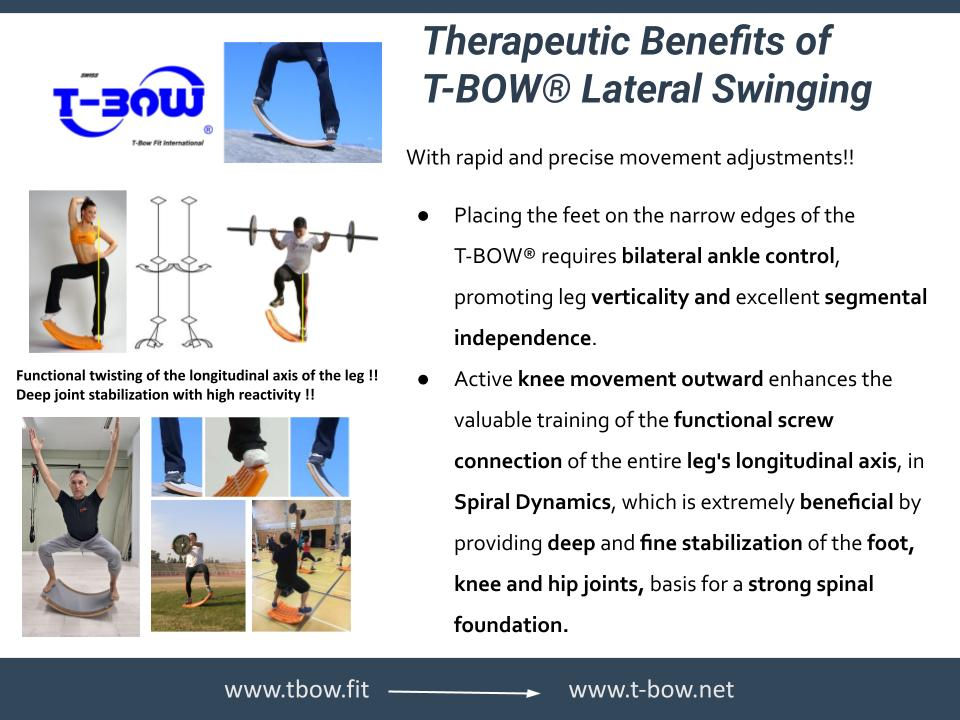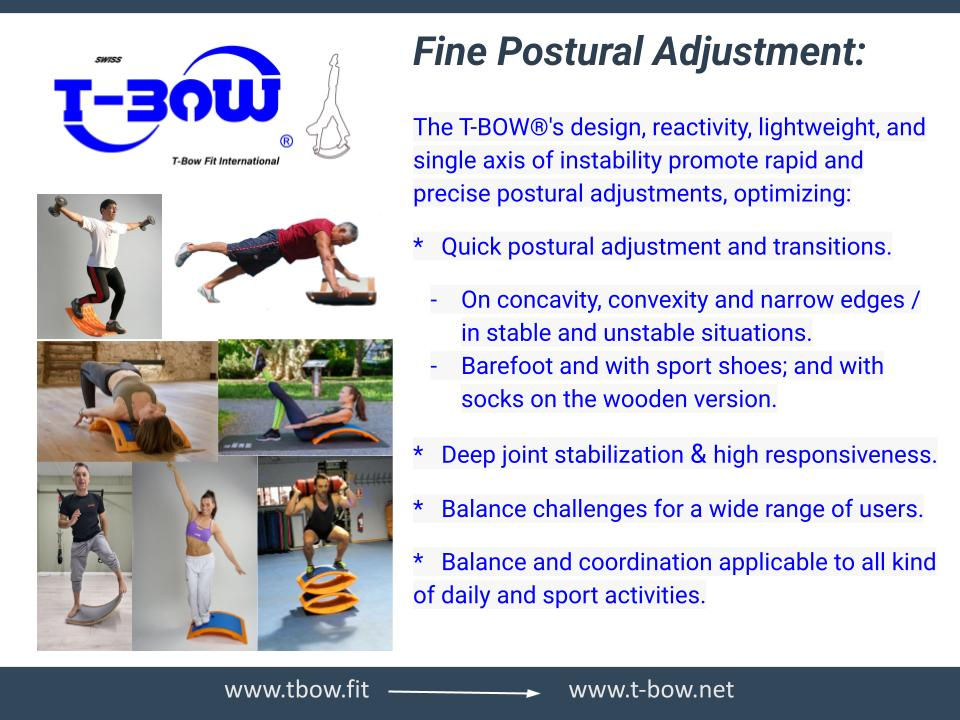Strength with the T-BOW® for Winter Sports
- T-BOW TRAINING AND THERAPY
- Jan 11, 2022
- 5 min read
Updated: Aug 16

T-BOW® provides options for training in concave and convex positions, plus its capacity to be combined with other sports equipment, allows an endless repertoire of different exercises for coordination, conditioning, and cognitive training. T-BOW ® provides very effective exercises for optimizing static and dynamic balance, with variable foot support positions, plus strength and mobility exercises for the trunk.
T-BOW® is therefore extraordinarily versatile for group classes and personalized training in the fields of health, physiotherapy, movement education-training, recreation and sports performance.
When training strength for winter sports the T-BOW ® provides the following advantages:
Sway-balance situations forcing bilateral control of the support of each foot (motor control with both sides of the foot) thanks to having to lean on the narrow lateral edges of the T-BOW®, stimulating the segmental independence of each leg and its differential dynamic relaxation, facts that extraordinarily optimize the balance of each leg and its balance by combining both legs; unlike balancing on flat platforms where the control of the support of each foot is very unilateral (on the side of the foot towards which it balances).
The balance on the T-BOW® allows to maintain the verticality of the leg, a fact that hyperstimulates the functional connection of the axis of the leg in interaction with the hip and trunk.

Therapeutic Benefits of T-BOW® Lateral Swinging
With rapid and precise movement adjustments!!
Placing the feet on the narrow edges of the T-BOW® requires bilateral ankle control, promoting leg verticality and excellent segmental independence.
Active knee movement outward enhances the valuable training of the functional screw connection of the entire leg's longitudinal axis, in spiral dynamics, which is extremely beneficial by providing deep and fine stabilization of the foot, knee and hip joints, basis for a strong spinal foundation.
The high level of reactivity of the T-BOW® optimizes very fine, fast and rapid postural adjustments (unlike softer and less reactive tools), both in its unstable position (for swinging or dynamic balances and static balances) and in the stable (for jumps and static and dynamic balances). From this high reactivity, the T-BOW® can be placed on surfaces with different levels of softness-elasticity to simulate the conditions of snow or mountainous terrain.

Fine Postural Adjustment
The T-BOW®'s design, reactivity, lightweight, and single axis of instability promote rapid and precise postural adjustments, optimizing:
* Quick postural adjustment and transitions.
- On concavity, convexity and narrow edges / in stable and unstable situations.
- Barefoot and with sport shoes; and with socks on the wooden version.
* Deep joint stabilization & high responsiveness.
* Balance challenges for a wide range of users.
* Balance and coordination applicable to all kinds of daily and sport activities.
A curved surface that allows great variability of independent or simultaneous support for simulating jumps, spins and re-balance.
Strength training in preferential conditions of speed, submaximal-maximal strength, fast strength (more-less speed and more-less elastic-reactive) or resistance strength, can be oriented with the T-BOW® towards specific strength levels. in more directed and special situations for sports such as skiing and snowboarding.
A relevant detail will be to carefully select the surface on which we train with the T-BOW® in such a way that it distorts the specific haptic sensitivity of skiing and snowboarding as little as possible.
Although the design of strength exercises by levels of approach in specificity offers many alternatives, we have experienced that sequences of three exercises are effective for many individuals.
Two basic examples applied to conditional training for skiing are shown:
Orientation towards rapid-strength:

4-6 wide swings with loaded bar on the shoulders.
8-10 ballistic throws starting with weight on one foot and ending in equilibrium.
Contrast coordination supports and turns variability in multidirectional unbalanced position.
Orientation towards resistance-strength:

Successive jumps on a curved elastic plane, then slowing the speed down.
Short and quick balance in half squat position, then slowing the speed down.
Compensatory postural balance using the hands for support, rocking slowly with control.
Only a few training ideas have been shown and both the load, the specific orientation of the load, the execution conditions of each exercise, as well as the planning of the loads, must be personalized for each athlete !!
Likewise, it is very important to have optimal levels of adjuvant strength and basic general strength, especially in squat exercises, to be able to safely and effectively apply the most targeted and special strength exercise proposals for skiing and snowboarding.
Tips for Coaches:
* For individuals who ski and/or snowboard at a more recreational level, albeit regularly: a) give priority attention to maintaining optimal adjuvant and general strength levels, especially in squat exercises, b) design strength exercises about the T-BOW® with 2-3 levels of specificity and types of strength balanced between those more oriented towards submaximal strength, rapid strength and endurance strength, c) plan 1-2 weekly strength sessions, combining general and directed levels depending on the challenges and motivations, d) in the most specific orientations, place under the T-BOW® the more-less soft and more-less reactive materials that simulate the haptic sensitivity of the snow conditions in which you are going to practice.
* For ski and/or snowboard athletes: a) if they are young in their beginner-improvement stages, design a strength program with all levels (general, directed, special and competitive) and prioritize general and directed levels with loads undulating for most of the season, reserving the special and competitive levels for brief periods with some competition considered very important, b) if they are athletes in their peak stage of performance, design a strength program with all levels (general, directed, special and competitive) and adapts its application according to the importance of each competition throughout the season, c) if they are athletes in their last years of sports life, plan the special and competitive levels for the entire season according to the importance competitively, d) in the most specific orientations, place under the T-BOW® the more-less soft and more-less reactive materials that simulate haptic sensitivity of the snow conditions in which it is expected to compete.
In the following videos you can find some examples of exercises that, obviously, will have to be personalized.
Authors:
Sandra Bonacina
Inventor of the T-BOW® and professor of physiotherapy and fitness at the University of Zurich.
Viktor Denoth
Developer of T-BOW® y professor of mountain sports at the University of Zurich.
David Ribera-Nebot
Technical Coordinator at Sport Training Barcelona (www.sporttraining.org)
Referencia:
Bonacina S (2005). Das mit dem multifunktionellen umgasende rainingsbogen training. Fitness Tribune, 93: 112-113. Seirul-lo Vargas F (1987). Sports Training Resources. INEF Barcelona.
Ribera-Nebot D (1986-90). Class notes of Master Seirul lo Vargas on the optimization of sports performance (entrenamientodeportivo.org). Non-published doc, Barcelona University.









Comments